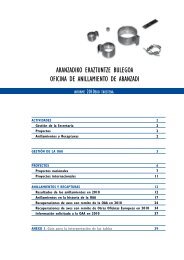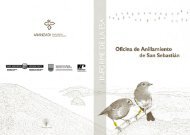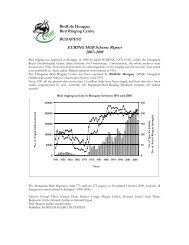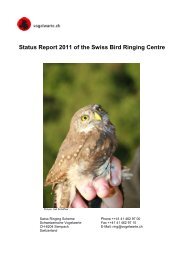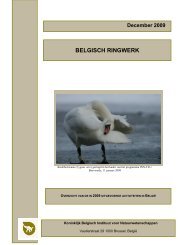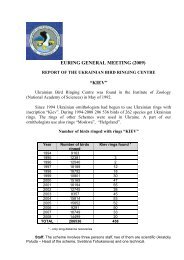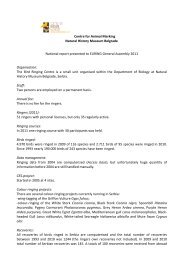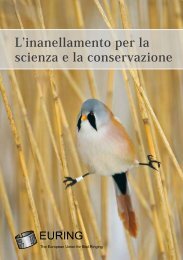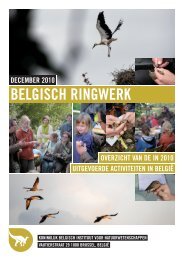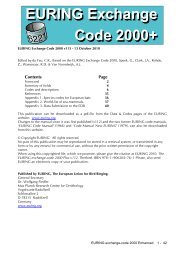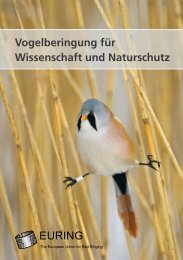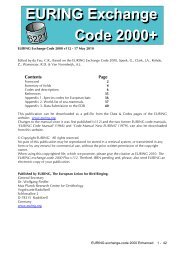Bird Ringing for Science and Conservation - The European Union ...
Bird Ringing for Science and Conservation - The European Union ...
Bird Ringing for Science and Conservation - The European Union ...
- No tags were found...
You also want an ePaper? Increase the reach of your titles
YUMPU automatically turns print PDFs into web optimized ePapers that Google loves.
<strong>Bird</strong> <strong>Ringing</strong> <strong>for</strong> <strong>Science</strong> <strong>and</strong> <strong>Conservation</strong><br />
<strong>Bird</strong> <strong>Ringing</strong> <strong>for</strong> <strong>Science</strong> <strong>and</strong> <strong>Conservation</strong><br />
Mist-nets are made of very thin nylon<br />
threads <strong>and</strong> are cheap <strong>and</strong> safe <strong>for</strong><br />
catching small birds, such as this male<br />
Lesser Redpoll.<br />
Kurt Pulfer<br />
Kurt Pulfer<br />
Satellite tracking<br />
One method that has added a new dimension to avian research in recent years is satellite<br />
tracking. Tiny transmitters, usually carried in harnesses strapped to the birds’ bodies,<br />
are linked to satellites. Each harness is custom-designed <strong>for</strong> each species <strong>and</strong> manually<br />
adjusted <strong>for</strong> each bird <strong>for</strong> maximum com<strong>for</strong>t of fit. <strong>The</strong> system enables researchers <strong>and</strong><br />
conservationists to track individual birds continuously.<br />
<strong>The</strong> results achieved by satellite tracking are ground-breaking. For the first time, the<br />
whole spatio-temporal pattern of successful migrations can be captured at a level of<br />
detail far exceeding that provided by ringing. Satellite tracking can also help discover unknown<br />
breeding, moulting or wintering areas of endangered species or causes of massive<br />
losses. When combined with other devices, such as thermometers or miniature cameras,<br />
additional in<strong>for</strong>mation of the bird’s behaviour may be transmitted to the satellite.<br />
However, satellite tracking will never replace bird ringing. <strong>The</strong> reasons <strong>for</strong> this are<br />
simple: transmitters are relatively expensive, a large amount of technical equipment is<br />
necessary, <strong>and</strong> the technique is limited to larger species (though transmitters now weigh<br />
as little as 10 g).<br />
EURING will incorporate data from satellite tracking into its database in order to ensure<br />
that these extremely valuable data are stored in perpetuity.<br />
An individually numbered ring is closed<br />
around the leg of a Hawfinch using specially<br />
produced ringing pliers.<br />
Kurt Pulfer<br />
Ingar Jostein Øien<br />
Kurt Pulfer<br />
www.piskulka.net<br />
Close scrutinity of the details of plumage<br />
may allow the ringer to identify the age<br />
<strong>and</strong> sex of the bird in the h<strong>and</strong>.<br />
Measuring a particular primary feather<br />
gives a good indication of overall size of<br />
an individual bird.<br />
<strong>The</strong> Lesser White-fronted Goose is at present one of Europe‘s most endangered<br />
bird species. <strong>The</strong> most important single threat throughout it’s range is the high<br />
mortality due to hunting <strong>and</strong> poaching. <strong>The</strong> core problem was, <strong>and</strong> partly still<br />
is, that the staging <strong>and</strong> wintering grounds <strong>for</strong> the species are virtually unknown.<br />
To locate them, a few individuals from the Fennosc<strong>and</strong>ian population were<br />
equipped with satellite transmitters. <strong>The</strong>y revealed a loop migration from the<br />
Norwegian breeding sites to the moulting area in arctic Siberia, <strong>and</strong> the winter<br />
quarters in Greece.<br />
6<br />
7



